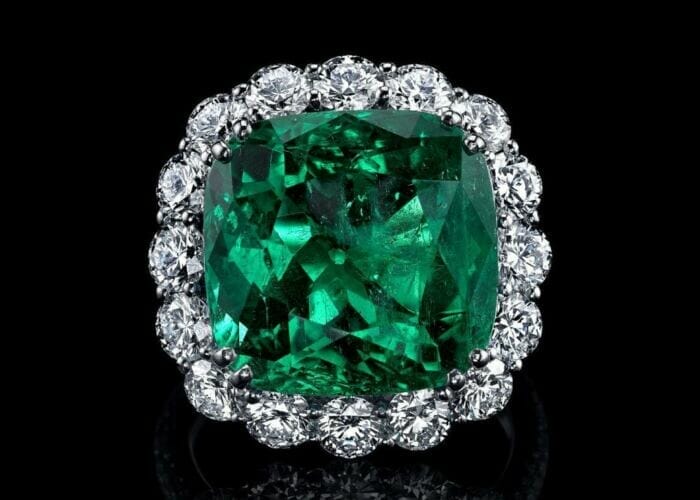Emerald has been synonymous with the color green since ancient times. A fine emerald is a truly breathtaking sight, and this member of the beryl family deserves its placement among the traditional “Big Four” gems along with diamond, ruby, and sapphire.
Like many stones, the per-carat price of fine quality emerald escalates rapidly with size. For example, a recent price guide lists a fine quality 3-ct Colombian stone as six times more valuable than three equivalent quality 1-ct stones.
Value factors hinge largely on color, with nuances of saturation and hue affecting price to a significant degree. The most desirable color is a slightly bluish green in a medium dark tone with strong to vivid saturation.
Clarity is important, but inclusions are tolerated more in emeralds than virtually any other gem. Top quality, unenhanced stones (with certification) can bring as much as 50% more in price than treated stones of the same size, color, and clarity.
Emeralds have fascinated people since ancient times. Not surprisingly, cultures from all over the world have developed a rich folklore around emeralds, and stories of famous emeralds have captivated people for centuries. Emerald is also the birthstone for May as well as the 20th and 35th wedding anniversary stone.
What Causes Emerald Color?
Emerald is a medium or darker green to blue-green beryl gemstone, in which the green color is derived from impurities of chromium (Cr), vanadium (V), or a combination of both. Before 1963, the definition of emerald was limited to beryls with chromium impurities, but the discovery in Brazil of a large deposit of beryl stones colored green by vanadium led to modification. According to the modern definition, the purity and saturation of the green color of a beryl is what defines an emerald.
Varying amounts of iron (Fe) will affect the color as well. More iron atoms increase the bluish tones.
Are All Green Beryls Emeralds?
In a situation similar to the division between pink sapphire and ruby, some chromium colored stones of light to medium-light green color are sometimes sold as emeralds though they could be considered green beryls. Emeralds should have a medium to dark primary green hue. (Editor’s note: Some gemologists, including Dr. Joel Arem, define emerald strictly as beryl that contains chromium and consider beryls colored green because of vanadium to be simply green beryls).
Do Emerald Colors Vary by Locality?
Geological conditions in Colombia produced exactly the slightly bluish-green shade and strong saturation that make stones from that locale the epitome of the variety.
Emeralds from the Muzo and Chivor mines in Colombia can be distinguished in a general way. Muzo material is yellowish green, whereas that from Chivor is blue-green. (It sometimes takes a trained eye to see the distinction in color, however).
Emeralds from Zambia may also display an unusual blue tone, with blue-green/yellow green pleochroism, due to their high iron content (0.73%). Zambian crystals may be intensely color zoned, with near colorless cores and dark green rims, almost like watermelon tourmaline.
Recently discovered emeralds from Itabira, Minas Gerais, Brazil, rival the best Colombian stones in quality. They are typically light bluish green down the c-axis.
Where are the Major Sources of Emeralds?
The center of world emerald mining is in South America, with Colombia and Brazil as major producers.
The Egyptian mines that supplied Cleopatra’s passion have long since been played out. However, today the African continent is second only to South America in production, with mines in Zambia, Zimbabwe, Madagascar, and Nigeria. Each of these locales typically produces a certain color, size, and clarity. Since 2016, Ethiopia has also produced some high-quality emeralds with grass green to blue-green colors that don’t need oil treatments.
Other notable sources of emeralds include Afghanistan and China.
As for consumers, the United States and Japan together purchase more than 75% of the world’s cut emeralds.
Care
Emerald rings should have protective settings to shield the gem from physical blows. Emeralds also make excellent choices for pendants, brooches, and earrings.
Mechanical cleaning is not recommended for emeralds. In the worst case, ultrasonic, steam, and boiling methods can shatter emeralds. At the very least, these methods will mean you’ll have to re-oil your emerald. Use only warm water, detergent, and soft brush for cleaning or take your emeralds to a professional jeweler.




